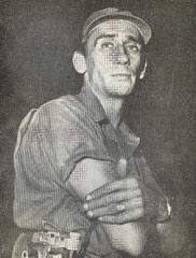4.1.3.1 The poetic work of Rolando Escardó (1925 – 1960)

Rolando Escardó’s short life did not prevent him from being known in the cultural circles of his time, although he did not publish any books during his lifetime, only poetry collections in various magazines during the Republican era and also in the first revolutionary year.
Born in Camagüey, he joined the clandestine struggle at a young age, resulting in imprisonment and exile in Mexico in 1958. Upon returning to Cuba in 1959, he was appointed lieutenant in the Rebel Army. In 1960, he suffered a car accident that led to his death while preparing for the First National Gathering of Poets, which also had revolutionary aims.
Escardó’s poetry was closely related to so-called neo-romanticism, in which the elegiac was an unavoidable anchor, as well as a certain existentialism that was increasingly expressed in a conversational tone, even though the latter had not yet been definitively established in Cuban poetry. However, the triumph of the Revolution also meant a profound upheaval in his worldview and aesthetic, which was now clearly committed to the revolutionary future of Cuban society.
Rolando Escardó’s literary work was not solely creative; from a young age, he dedicated himself to uniting the poetic movement of his generation, around the group “Los Nuevos,” which he founded in his home province, as well as the Yarabey Group, already in the final years of the Republican era. In 1953, he had published a selection of verses by José Martí.
His first verses from the revolutionary period were published in “Ciclón” and “Lunes de Revolución” (Monday of Revolution); however, he didn’t live long enough to see his work published in book form. This would happen in 1961, when Virgilio Piñera published “Libro de Rolando” (The Book of Rolando), and in the same year, Samuel Feijóo undertook the task of grouping several pieces under the title “Las Ráfagas” (The Gusts). His short collection of poems, “El jardín de las piedras” (The Garden of Stones), had also appeared in “Islas” (Santa Clara), a Spanish-language publication, thus marking a significant posthumous tribute.
The figure of Rolando Escardó and his early death had a profound impact on the cultural sphere of the nascent Revolution. Many poets and writers, in addition to those already mentioned, have paid tribute to him over time, as his voice has grown to this day. These include Félix Pita Rodríguez, who wrote the prologue to a “Minimal Anthology” of the bard’s poems in 1975; Luis Suardíaz, with his text “Orbit of Rolando Escardó”; and “Poetic Work,” edited by Enrique Saínz. More recently, the text “Islands and Other Poems,” compiled by poet and researcher Juan Nicolás Padrón, was published.
On the occasion of his death, the poet and also a member of her generation, Carilda Oliver Labra, conceived the endearing poem “Last Conversation with Rolando Escardó”, which is reproduced as a colophon:
“Happy guest of terror,
guest of hunger,
fabulous,
I can talk to you now.
It is that hour
in which your lonely voice restored my home;
that hour of you
-cheater walking in the violet,
illustrious earless man of the Plaza del Vapor-;
that hour of seeing your bones together.
What a time forever!
Time to say goodbye without knowing it,
to see lately
your eyes of starry swamp,
your gosh eyes and I want
that misery used like two green rags;
your eyes that I later closed
so that they would not be filled with death.
I don’t cry,
in the chapter,
I don’t curse;
In your honor be the bats
and the mists you loved.
I think your blood reverberates in the cooperatives,
that you are that roundabout of the ceibas,
that poor forehead saving itself
and your jeep keeps bumping around in the Revolution.”








